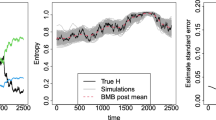Abstract
Finding geographical patterns by analysing the spatial configuration distribution of events, objects or their attributes has a long history in geography, ecology and epidemiology. Measuring the presence of patterns, clusters, or comparing the spatial organisation for different attributes, symbols within the same map or for different maps, is often the basis of analysis. Landscape ecology has provided a long list of interesting indicators, e.g. summaries of patch size distribution. Looking at content information, the Shannon entropy is also a measure of a distribution providing insight into the organisation of data, and has been widely used for example in economical geography. Unfortunately, using the Shannon entropy on the bare distribution of categories within the spatial domain does not describe the spatial organisation itself. Particularly in ecology and geography, some authors have proposed integrating some spatial aspects into the entropy: using adjacency properties or distances between and within categories. This paper goes further with adjacency, emphasising the use of co-occurences of categories at multiple orders, the adjacency being seen as a particular co-occurence of order 2 with a distance of collocation null, and proposes a spatial entropy measure framework. The approach allows multivariate data with covariates to be accounted for, and provides the flexibility to design a wide range of spatial interaction models between the attributes. Generating a multivariate multinomial distribution of collocations describing the spatial organisation, allows the interaction to be assessed via an entropy formula. This spatial entropy is dependent on the distance of collocation used, which can be seen as a scale factor in the spatial organisation to be analysed.
Preview
Unable to display preview. Download preview PDF.
Similar content being viewed by others
References
Shannon, C.: A mathematical theory of communication. Bell System Technical Journal 27, 379–423, 623–656 (1948)
Bogaert, J., Farina, A., Ceulemans, R.: Entropy increase of fragmented habitats: A sign of human impact? Ecological Indicators 5(3), 207–212 (2005)
Batty, M.: Spatial entropy. Geographical Analysis 6, 1–31 (1974)
Snickars, F., Weibull, J.: A minimum information principle: Theory and practice. Regional Science and Urban Economics 7, 137–168 (1977)
Cutrini, E.: Using entropy measures to disentangle regional from national localization patterns. regional science and urban economics. Regional Science and Urban Economics 39(2), 243–250 (2009)
Karlström, A., Ceccato, V.: A new information theoretical measure of global and local spatial association: S. The Review of Regional Research 22, 13–40 (2002)
O’Neill, R., Krummel, J., Gardner, R., Sugihara, G., Jackson, B., DeAngelis, D., Milne, B., Turner, M., Zygmunt, B., Christensen, S., Dale, V., Graham, R.: Indices of landscape pattern. Landscape Ecology 1(3), 153–162 (1988)
Li, H., Reynolds, J.F.: A new contagion index to quantify spatial patterns of landscapes. Landscape Ecology 8, 155–162 (1993)
Li, Z., Huang, P.: Quantitative measures for spatial information of maps. International Journal of Geographical Information Science 16(7), 699–709 (2002)
Maitre, H., Bloch, I., Sigelle, M.: Spatial entropy: a tool for controlling contextual classification convergence. In: Proceedings of IEEE International Conference on Image Processing, ICIP 1994, vol. 2, pp. 212–216 (1994)
Tupin, F., Sigelle, M., Maitre, H.: Definition of a spatial entropy and its use for texture discrimination. In: International Conference on Image Processing, vol. 1, pp. 725–728 (2000)
Claramunt, C.: A spatial form of diversity. In: Cohn, A.G., Mark, D.M. (eds.) COSIT 2005. LNCS, vol. 3693, pp. 218–231. Springer, Heidelberg (2005)
Li, X., Claramunt, C.: A spatial entropy-based decision tree for classification of geographical information. Transactions in GIS 10(3), 451–467 (2006)
Leibovici, D., Bastin, L., Jackson, M.: Discovering spatially multiway collocations. In: GISRUK Conference 2008, Manchester, UK, April 2-4, 2008, pp. 66–71 (2008)
Diggle, P.J.: Statistical Analysis of Spatial Point Patterns. Hodder Arnold, London (2003)
Baddeley, A., Turner, R.: spatstat: An r package for analyzing spatial point patterns. Journal of Statistical Software 12(6) 1, 1–42 (2005)
Leibovici, D., Sabatier, R.: A Singular Value Decomposition of k-Way Array for a Principal Component Analysis of Multiway Data. PTA-k. Linear Algebra and Its Applications 269, 307–329 (1998)
Leibovici, D.: PTAk: Principal Tensor Analysis on k modes. Contributing R-package version 1.1-16 (2007)
Bhati, A.S.: A generalized cross-entropy approach for modeling spatially correlated counts. Econometric Reviews 27(4), 574–595 (2008)
Wuest, L.J., Nickerson, B., Mureika, R.: Information entropy of non-probabilistic processes. Geographical Analysis 35(3), 215–248 (2003)
Shi, Y., Jin, F., Li, M.: A total entropy model of spatial data uncertainty. Journal of Information Science 32(4), 316–323 (2006)
Author information
Authors and Affiliations
Editor information
Editors and Affiliations
Rights and permissions
Copyright information
© 2009 Springer-Verlag Berlin Heidelberg
About this paper
Cite this paper
Leibovici, D.G. (2009). Defining Spatial Entropy from Multivariate Distributions of Co-occurrences. In: Hornsby, K.S., Claramunt, C., Denis, M., Ligozat, G. (eds) Spatial Information Theory. COSIT 2009. Lecture Notes in Computer Science, vol 5756. Springer, Berlin, Heidelberg. https://doi.org/10.1007/978-3-642-03832-7_24
Download citation
DOI: https://doi.org/10.1007/978-3-642-03832-7_24
Publisher Name: Springer, Berlin, Heidelberg
Print ISBN: 978-3-642-03831-0
Online ISBN: 978-3-642-03832-7
eBook Packages: Computer ScienceComputer Science (R0)




